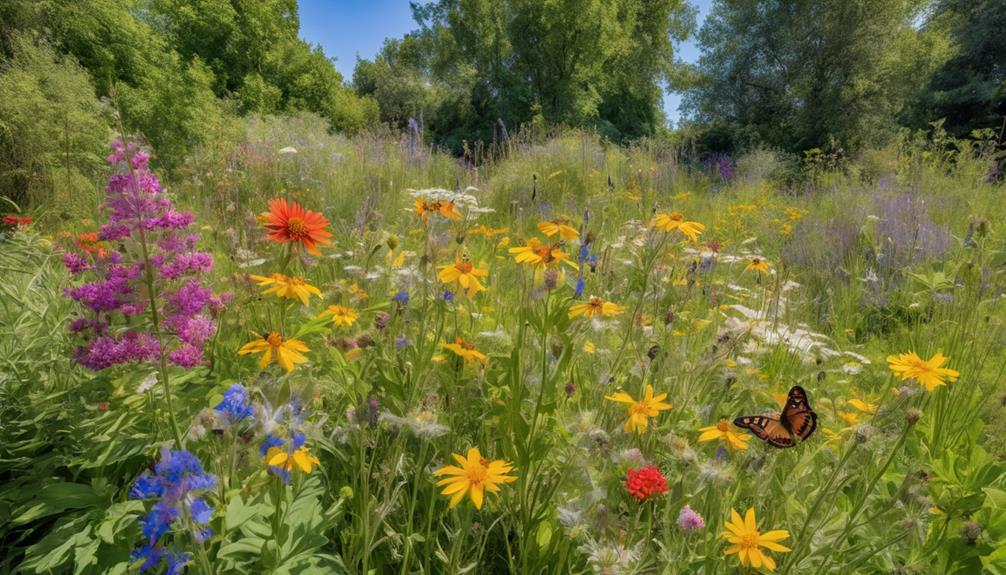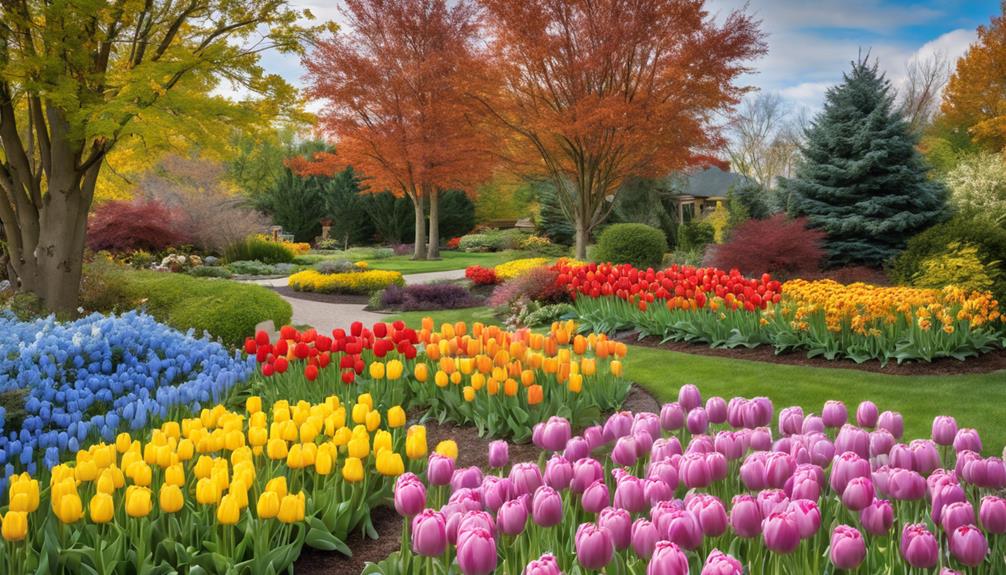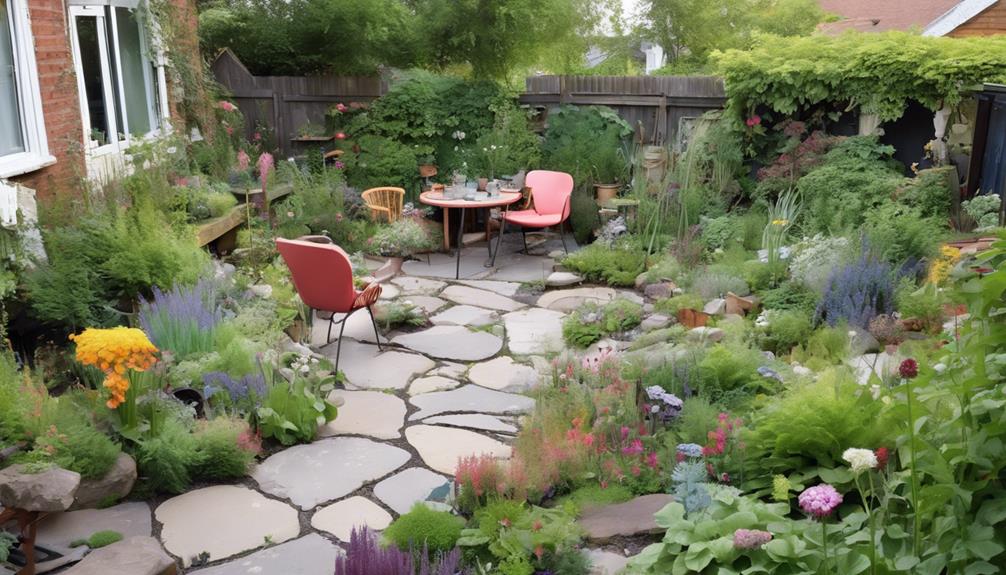Pressure Washing: Benefits for Your Garden’s Health
2 February 2025
7 Best Creative Ideas for Urban Backyard Gardens
2 February 2025Native plant gardens offer significant benefits, enhancing biodiversity by attracting local wildlife, including vital pollinators. They contribute to ecosystem resilience, forming stable habitats that support complex food webs.
Furthermore, these gardens improve soil health and promote water conservation through drought-resistant plants with deep root systems. The design and selection of local native species are important for maximising ecological advantages while minimising maintenance.
In general, native plant gardens not only enrich the environment but also create aesthetically pleasing spaces. For those interested in optimising their gardening efforts, further insights are available on effective design and maintenance strategies.
Native Plants Enhance Biodiversity
Native plants play an essential role in enhancing biodiversity by attracting local wildlife, such as pollinators and birds, that rely on these species for food and habitat.
Furthermore, they contribute to ecosystem resilience by creating a balanced environment that can better withstand environmental changes and disturbances.
Attract Local Wildlife
Biodiversity is a critical component of healthy ecosystems, and incorporating native plant gardens plays a significant role in promoting this richness of life.
Native plants provide crucial food sources and habitats for local wildlife, including pollinators, birds, and beneficial insects. By cultivating native species, gardeners create an environment that supports complex food webs and encourages species interactions.
These plants are adapted to local conditions, offering resilience to pests and diseases, which further attracts diverse fauna. The interdependence between native flora and fauna fosters ecological balance, enhancing the overall health of the environment.
As a result, native plant gardens not only beautify landscapes but also serve as important sanctuaries for local wildlife, contributing to the preservation of regional biodiversity.
Promote Ecosystem Resilience
How can the resilience of an ecosystem be reinforced? One potent strategy involves the incorporation of native plants, which serve as the foundation for local biodiversity.
Native plants are well-adapted to their environments, fostering intricate relationships with indigenous fauna, including pollinators and herbivores. This symbiotic interaction enhances ecosystem stability, allowing for greater resistance to disturbances such as invasive species and climate fluctuations.
Additionally, native plant gardens support diverse microbial communities in the soil, which are essential for nutrient cycling and overall ecosystem health. By cultivating native flora, we not only promote biodiversity but also create a robust ecological framework capable of withstanding environmental pressures.
Ultimately, native plant gardens function as critical reservoirs of resilience, ensuring the sustainability of local ecosystems.
Environmental Impact Considerations
The adoption of native plant gardens presents significant environmental benefits that warrant careful consideration.
By enhancing soil health, promoting water conservation, and attracting essential pollinators, these gardens contribute positively to ecosystem stability.
Understanding these impacts is fundamental for maximising the ecological advantages of native plant landscaping.
Soil Health Improvement
Native plant gardens play a crucial role in improving soil health, which is foundational for sustaining local ecosystems. By cultivating native species, gardeners can foster a thriving soil environment that supports biodiversity and mitigates erosion.
The deep root systems of native plants enhance soil structure and aeration, while also facilitating nutrient cycling. Furthermore, these gardens contribute to the proliferation of beneficial microorganisms and organic matter.
Key benefits of native plant gardens for soil health include:
- Increased soil fertility through natural organic matter decomposition
- Improved water infiltration and retention capabilities
- Reduced soil compaction due to deep root systems
- Promotion of diverse microbial communities
- Minimisation of erosion through robust root structures
These factors collectively contribute to resilient and productive soil ecosystems.
Water Conservation Benefits
Water conservation is a critical benefit of native plant gardens, significantly impacting local ecosystems and resource management. Native plants are well-adapted to their environments, requiring less water than non-native species. This efficiency not only reduces the need for irrigation but also promotes sustainability in water usage.
The following points highlight the importance of water conservation in native plant gardens:
- Drought Resistance: Native plants often thrive in local climatic conditions, minimising water dependence.
- Soil Retention: Deep root systems improve water infiltration and retention.
- Reduced Runoff: Native gardens enhance water absorption, decreasing surface runoff.
- Lower Maintenance Needs: Less frequent watering translates to reduced resource expenditure.
- Biodiversity Support: Healthy ecosystems require balanced water management, benefiting all organisms involved.
Pollinator Support and Attraction
Creating a garden that incorporates native plants greatly enhances pollinator support and attraction, which is crucial for maintaining healthy ecosystems. Native plants provide the necessary resources for a diverse array of pollinators, such as bees, butterflies, and hummingbirds, fostering biodiversity and ecological resilience.
The benefits of such gardens include:
- Increased Pollinator Diversity: Attracts a wider range of pollinator species.
- Sustained Pollination Services: Ensures the continuity of pollination for food crops and wild flora.
- Enhanced Habitat: Offers shelter and breeding grounds for pollinators.
- Reduced Pesticide Dependency: Minimises the need for chemical interventions, benefiting pollinator health.
- Educational Opportunities: Acts as a living laboratory for understanding ecosystems and conservation.
Select Local Native Species
Selecting local native species is crucial for establishing a thriving garden that supports local ecosystems.
When choosing your planting area, consider factors such as sunlight and soil type to optimise growth.
Furthermore, incorporating mulch and appropriate soil amendments can improve moisture retention and provide vital nutrients for your native plants.
Choose Your Planting Area
When embarking on the journey of establishing a native plant garden, it is crucial to first identify the specific planting area that will best support local native species.
Selecting the appropriate site ensures ideal growth conditions and enhances ecological benefits.
Consider the following factors when choosing your planting area:
- Sunlight Exposure: Assess how much sunlight the area receives throughout the day.
- Soil Quality: Test the soil for pH, drainage, and nutrient levels to determine its suitability.
- Moisture Availability: Evaluate natural water sources and drainage patterns.
- Space for Growth: Ensure there is sufficient room for plant expansion and biodiversity.
- Proximity to Existing Ecosystems: Locate the garden near other native habitats to encourage wildlife attraction.
Choosing the right planting area is fundamental to a thriving native plant garden.
Mulch to Retain Moisture
After determining the ideal planting area, incorporating mulch into your native plant garden can significantly improve moisture retention and enhance soil health.
Mulch serves as a protective layer that reduces evaporation, maintains consistent soil temperature, and suppresses weeds. Choosing the right type of mulch is crucial; organic mulches, such as shredded bark or leaves, can enrich soil fertility over time as they decompose.
Consider the following benefits of using mulch:
- Moisture retention: Reduces water loss from the soil.
- Weed suppression: Deters weed growth, minimising competition for resources.
- Temperature regulation: Helps maintain stable soil temperatures.
- Soil structure improvement: Boosts aeration and drainage as it decomposes.
- Erosion control: Protects soil from erosion during heavy rains.
Soil Amendments for Native Plants
Enhancing soil health through the use of appropriate amendments is essential for the successful establishment of native plants.
These plants often flourish in specific soil conditions, necessitating careful consideration of amendments that can optimise their growth potential.
When selecting soil amendments, consider the following:
- Organic Matter: Improves soil structure and nutrient retention.
- Compost: Provides a balanced source of nutrients and beneficial microorganisms.
- Mulch: Reduces evaporation and improves soil temperature regulation.
- pH Adjusters: Tailor soil acidity or alkalinity to meet specific plant needs.
- Mycorrhizal Inoculants: Promotes root health and nutrient uptake.
Wildlife Habitat Creation
Native plant gardens play a crucial role in creating wildlife habitats that support biodiversity. By utilising indigenous flora, these gardens provide vital resources such as food, shelter, and nesting sites for numerous species. Native plants attract pollinators, including bees and butterflies, while also serving as a food source for birds and small mammals. The following table illustrates the key benefits of native plant gardens for wildlife:
| Benefit | Description |
|---|---|
| Food Sources | Provides nectar, seeds, and fruits for wildlife |
| Shelter | Offers protective cover for nesting and roosting |
| Pollinator Attraction | Draws bees, butterflies, and other pollinators |
| Ecosystem Support | Improves local ecosystems and soil health |
| Biodiversity Improvement | Increases species variety and ecological resilience |
These elements collectively foster a thriving ecosystem, underscoring the importance of native plant gardens in wildlife conservation efforts.
Native Plant Design Services
Native plant design services offer tailored solutions to create vibrant ecosystems that support local wildlife.
These services include pollinator-friendly garden design, bespoke layouts that optimise biodiversity, and specialised irrigation systems to enhance plant health.
Pollinator-Friendly Garden Design
Frequently overlooked in traditional landscaping, pollinator-friendly garden design plays a crucial role in supporting local ecosystems and biodiversity.
By incorporating native plants, such gardens not only attract vital pollinators like bees, butterflies, and hummingbirds but also create habitats for numerous wildlife.
Effective design strategies can optimise these benefits, ensuring a thriving environment.
- Select a variety of native plants to provide year-round blooms.
- Group plants in clusters to improve foraging efficiency for pollinators.
- Incorporate different flower shapes and sizes to accommodate various pollinator species.
- Avoid pesticides to maintain a safe haven for pollinators.
- Create water sources such as bird baths or shallow dishes for hydration.
Implementing these principles fosters a vibrant, sustainable ecosystem while enhancing the aesthetic appeal of your landscape.
Custom Native Plant Layouts
Creating an inviting and functional landscape that supports local wildlife can be significantly enhanced through custom native plant layouts.
These tailored designs improve ecological benefits while also enhancing aesthetic appeal. A systematic approach ensures that the specific conditions of your site are taken into account, leading to a thriving native plant garden.
Key aspects to consider include:
- Soil Type: Understanding soil composition for optimal plant health.
- Sunlight Exposure: Evaluating light conditions for appropriate plant selection.
- Water Availability: Reviewing drainage and moisture levels.
- Biodiversity Goals: Incorporating a variety of native species to attract wildlife.
- Seasonal Interest: Designing for year-round visual appeal and ecological function.
Investing in custom native plant layouts ultimately fosters a sustainable environment that benefits both flora and fauna.
Custom Irrigation System Design
A well-designed irrigation system is vital for the success of any native plant garden, ensuring that each species receives the appropriate amount of water to thrive.
Custom irrigation system design takes into account the unique water requirements of native plants, promoting their health and sustainability.
Key elements of an effective irrigation system include:
- Soil moisture assessment to determine watering needs.
- Drip irrigation for targeted water delivery to the root zone.
- Rainwater harvesting systems to utilise natural precipitation.
- Smart irrigation controllers to optimise water usage based on weather conditions.
- Regular maintenance to ensure system efficiency and longevity.
Plant Selection Difficulties
Selecting appropriate native plants can pose challenges due to limited availability at local nurseries.
Furthermore, community plant exchange programmes may offer a viable alternative, yet their success often depends on participation and awareness.
Addressing these issues is essential for promoting the establishment of thriving native plant gardens.
Limited Local Plant Availability
Limited local plant availability can pose significant challenges for gardeners seeking to create native plant gardens. This scarcity can hinder the establishment of diverse ecosystems and limit the effectiveness of planting efforts.
Gardeners must navigate several issues, including:
- Limited Species Diversity: A narrow selection of native plants may restrict ecological benefits.
- Seasonal Availability: Some species may only be available during specific times of the year, affecting planting schedules.
- Quality Variability: Inconsistent quality of locally sourced plants can lead to poor garden outcomes.
- Lack of Information: Insufficient knowledge about suitable local species can result in misguided choices.
- Transportation Barriers: Difficulty in accessing distant nurseries can complicate sourcing efforts.
These factors necessitate strategic planning and resourcefulness for successful native gardening.
Local Nurseries for Native Plants
Many gardeners encounter difficulties when exploring local nurseries for native plants, primarily due to inconsistencies in plant selection. This lack of standardisation can create challenges for those aiming to cultivate authentic native gardens.
Factors contributing to these issues include:
- Limited knowledge of native species among nursery staff
- Seasonal availability fluctuations impacting selection
- Mislabeling of plants, leading to confusion
- Insufficient diversity of native options
- Inconsistent sourcing practices, affecting plant quality
To navigate these challenges, gardeners should conduct thorough research on local plant species, seek out specialised nurseries, and engage with knowledgeable staff.
Such proactive measures can improve the likelihood of successful plant selection, ensuring a thriving native plant garden that contributes positively to the local ecosystem.
Community Plant Exchange Programs
Community plant exchange programmes offer a valuable opportunity for gardeners to diversify their native plant selections; however, participants often face challenges in ensuring the quality and authenticity of the plants being exchanged.
These difficulties can undermine the benefits of such programmes. To navigate these issues effectively, participants should consider the following strategies:
- Research: Investigate the species and their suitability for local ecosystems.
- Documentation: Request provenance information to verify plant origins.
- Network: Connect with seasoned gardeners for recommendations on trustworthy participants.
- Inspection: Examine plants carefully for pests and diseases prior to exchange.
- Education: Attend workshops to deepen understanding of native plants and their care.
Why Choose TKL Birmingham Gardener
When selecting a gardening service, the expertise and dedication of TKL Birmingham Gardener stand out as a compelling choice for those looking to cultivate native plant gardens.
Their profound understanding of local ecosystems ensures that the chosen plants thrive harmoniously within the environment, enhancing biodiversity while reducing maintenance requirements.
TKL Birmingham Gardener employs a tailored approach, assessing individual site conditions to recommend the most suitable native species.
Their commitment to sustainable practices not only fosters ecological balance but also promotes water conservation and soil health.
Additionally, their professional team provides ongoing support and education, empowering clients with the knowledge to care for their gardens.
Choosing TKL Birmingham Gardener means investing in a flourishing native landscape that reflects both beauty and ecological integrity.
Common Native Plant Questions
As interest in native plant gardens grows, potential gardeners often find themselves with a range of questions regarding these eco-friendly landscapes.
Common inquiries typically revolve around plant selection, local climate adaptability, and soil conditions. Gardeners frequently ask which native species attract beneficial wildlife, such as pollinators, and how to source these plants sustainably.
Furthermore, concerns about maintenance, including pruning and watering requirements, are prevalent. Understanding the seasonal dynamics of native plants can also pose questions, particularly regarding blooming periods and dormancy.
Ultimately, many seek guidance on integrating native gardens into existing landscapes while maintaining aesthetic appeal. Addressing these questions is crucial for fostering successful, sustainable gardening practices that contribute to local ecosystems.
Plan Seasonal Maintenance Routines
Establishing a well-defined seasonal maintenance routine is essential for the health and longevity of native plant gardens. By adhering to a structured schedule, gardeners can ensure optimal growth and vigour of their plants.
A strategic approach incorporates the following vital tasks:
- Spring: Assess soil health and apply organic fertilisers; prune dead or damaged foliage.
- Summer: Monitor moisture levels; implement irrigation techniques if necessary to combat drought.
- Autumn: Cut back perennials; remove invasive species to promote biodiversity.
- Winter: Protect sensitive plants with mulch; plan for the next season's planting.
- Year-Round: Conduct regular inspections for pests and diseases; maintain a journal to track observations and results.
This meticulous care improves the ecosystem's resilience while celebrating the natural beauty of native flora.




